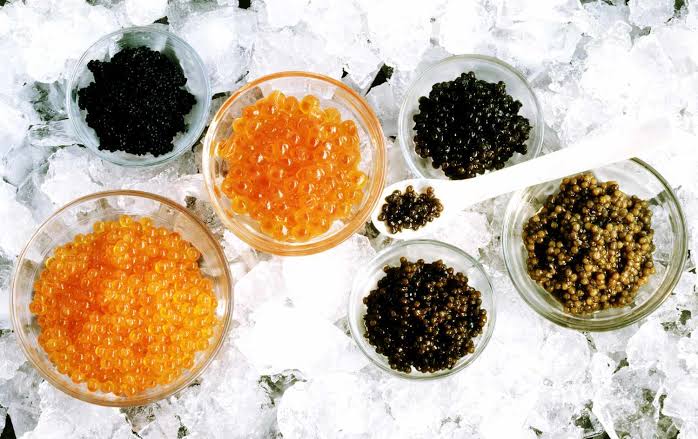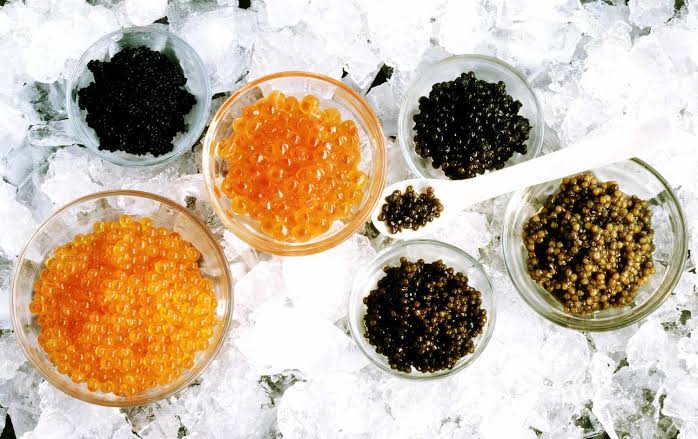Types of Caviar: Exploring the World of Luxurious Delicacy

Caviar, often referred to as the “black gold” of the culinary world, is a luxurious delicacy that has been revered for centuries. Known for its distinctive taste, texture, and exclusive status, caviar has captured the hearts and palates of connoisseurs around the globe. In this article, we will take a deep dive into the fascinating world of caviar, exploring the different types of caviar that grace gourmet tables and how they contribute to a lavish dining experience.
Types of Caviar
Beluga Caviar:
Beluga caviar, hailed as the pinnacle of indulgence, is derived from the roe of the Beluga sturgeon. Recognizable by its large, glossy beads that range from pale silver to dark grey, Beluga caviar offers a buttery, delicate flavor that melts in the mouth. Its exquisite taste is often described as subtle and nutty, making it a cherished choice for haute cuisine. The rarity and impressive size of the Beluga sturgeon contribute to the exclusivity of this caviar, making it a symbol of opulence.
Osetra Caviar:
Osetra caviar, obtained from the Osetra sturgeon, showcases a spectrum of colors that can range from golden to deep brown. The beads are medium-sized and boast a rich, nutty flavor profile with hints of sea breeze. This type of caviar is renowned for its complex taste and versatility, pairing perfectly with a wide range of culinary creations. Osetra caviar’s popularity lies in its balance of flavors and textures, making it a favorite among discerning gourmands.
Sevruga Caviar:
Sevruga caviar, harvested from the Sevruga sturgeon, boasts small, dark pearls that exhibit a robust and bold flavor. With a slightly tangy and intense taste, Sevruga caviar is a delight for those who appreciate a stronger seafood essence. Its smaller size and distinctive taste make it a unique addition to various dishes, adding a burst of flavour that elevates the overall dining experience.
Kaluga Caviar:
Kaluga caviar, often referred to as “River Beluga,” is sourced from the Kaluga sturgeon. This caviar variety stands out due to its large, firm beads that range from dark brown to light amber. The taste is reminiscent of the revered Beluga caviar, offering a smooth and buttery character with a hint of sweetness. Kaluga caviar presents an opportunity to relish a Beluga-like experience with a distinctive touch, capturing the essence of luxury.
Hackleback Caviar:
Hackleback caviar, originating from the Hackleback sturgeon, is known for its petite, jet-black eggs that exude a subtle, earthy flavor. With a slightly firmer texture, Hackleback caviar delivers a delicate pop in the mouth. This type of caviar is celebrated for its accessibility and affordability, making it an excellent introduction to the world of caviar for those new to its splendor.
Paddlefish Caviar:
Paddlefish caviar, sourced from the American paddlefish, showcases small to medium-sized eggs that range in color from light gray to dark black. It offers a mild, refined taste that carries a hint of brininess, making it a versatile choice for various culinary applications. Paddlefish caviar is prized for its elegant appearance and approachable flavour, catering to both connoisseurs and newcomers alike.

Frequently Asked Questions (FAQs)
What makes caviar so expensive?
Caviar’s high cost is primarily attributed to the lengthy and delicate process of harvesting and preparing the roe. Sturgeon, the source of most caviar, take years to mature, and the extraction of roe requires precision and expertise. Additionally, the rarity of certain sturgeon species contributes to the exclusivity and luxury associated with caviar.
How should I serve and enjoy caviar?
Caviar is best enjoyed simply to fully appreciate its unique taste. Serve it chilled on a bed of ice or alongside blinis, sour cream, minced onion, or lemon wedges. Use a mother-of-pearl or wooden spoon to avoid altering the caviar’s delicate flavour.
Are there sustainable options for caviar consumption?
Yes, sustainable caviar options exist. Look for caviar produced through ethical farming practices and strict conservation measures. These efforts ensure the preservation of sturgeon populations and the environment.
Can I pair caviar with beverages?
Absolutely. Champagne and other sparkling wines are classic accompaniments to caviar, as the effervescence complements the rich texture and flavour of the roe. Vodka is also a popular choice, as its clean profile cleanses the palate between bites.
How do I differentiate between various caviar types?
Observe the colour, size, and texture of the eggs. Additionally, pay attention to the flavour notes—some are buttery, while others are more intense or nutty. Consulting with knowledgeable caviar purveyors can provide valuable insights.
Is there a vegan alternative to caviar?
Yes, some innovative brands offer vegan caviar alternatives made from seaweed or other plant-based ingredients. While they may not replicate the exact taste, they provide a similar aesthetic and texture.
Conclusion
In the world of culinary indulgence, few delicacies rival the allure of caviar. The diverse types of caviar, each with its distinct characteristics and nuances, promise a journey of taste and sophistication. From the lavish Beluga to the accessible Hackleback, caviar offers a range of options to cater to different palates and preferences. So, the next time you’re looking to elevate your dining experience, consider exploring the captivating world of caviar, where opulence meets flavour.


